U.S.S. Saratoga Overview
Created by Captain Zseeq on Sun Dec 10th, 2023 @ 4:31am
General Overview
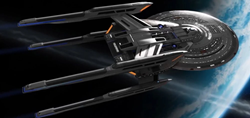 The U.S.S. Saratoga NCC-31911-B, is the second Starfleet vessel named in honor of the Miranda Class U.S.S. Saratoga NCC-31911, the sixth Starfleet vessel to be named in honor of the American Revolutionary War Battle of Saratoga, and is the 13th Sagan Class starship built by the Federation. Despite its relatively short career, the Saratoga has received a reputation among Starfleet as being an unlucky vessel as it has been involved in several high-profile incidents during its short career.
The U.S.S. Saratoga NCC-31911-B, is the second Starfleet vessel named in honor of the Miranda Class U.S.S. Saratoga NCC-31911, the sixth Starfleet vessel to be named in honor of the American Revolutionary War Battle of Saratoga, and is the 13th Sagan Class starship built by the Federation. Despite its relatively short career, the Saratoga has received a reputation among Starfleet as being an unlucky vessel as it has been involved in several high-profile incidents during its short career.
History
Construction and Launch
 Construction of the Saratoga began on Stardate 62258.4 at Federation Space Systems on Terra Nova. The start of construction was seen as a positive by the local population of Terra Nova as the Saratoga was part of the new Sagan Class and could see the rise in prominence of their shipbuilding as the Starfleet Corps of Engineers had previously used Federation Space Systems to build older, established classes and not cutting-edge vessels. The local government pulled the Saratoga's construction into their celebration of First Contact Day for 2385 as a result, coinciding the start with the start of festivities on Earth. Their celebration was quickly overshadowed by the Attack on Mars by rogue synthetics, which led to the destruction of the Utopia Planitia Shipyards, the Martian atmosphere being set ablaze, and the death of 92,143 people.
Construction of the Saratoga began on Stardate 62258.4 at Federation Space Systems on Terra Nova. The start of construction was seen as a positive by the local population of Terra Nova as the Saratoga was part of the new Sagan Class and could see the rise in prominence of their shipbuilding as the Starfleet Corps of Engineers had previously used Federation Space Systems to build older, established classes and not cutting-edge vessels. The local government pulled the Saratoga's construction into their celebration of First Contact Day for 2385 as a result, coinciding the start with the start of festivities on Earth. Their celebration was quickly overshadowed by the Attack on Mars by rogue synthetics, which led to the destruction of the Utopia Planitia Shipyards, the Martian atmosphere being set ablaze, and the death of 92,143 people.
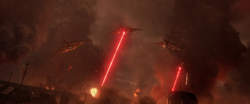 The disaster at Mars led to significant changes throughout the Federation and the construction of the Saratoga was not immune from them. Investigations determined that the assault was committed by rogue synthetic construction workers who disabled planetary defenses and began murdering their living coworkers. As a result, the Federation Council outlawed all synthetic life within the Federation. Immediately, Federation Space Systems was directed to retire their A500 workforce and rely on traditional workers for construction of their vessels. This quickly altered the timetable for construction of the Saratoga as construction with the A500s was estimated to take two years while traditional labor would take nearly six years to the planned development. The challenge, however, was that Starfleet Command and the Starfleet Corps of Engineers did not support a lengthened timetable as Starfleet was decimated by the destruction of Utopia Planitia and the canceled Romulan Relocation Effort. Federation Space Systems was given an additional year, but no longer.
The disaster at Mars led to significant changes throughout the Federation and the construction of the Saratoga was not immune from them. Investigations determined that the assault was committed by rogue synthetic construction workers who disabled planetary defenses and began murdering their living coworkers. As a result, the Federation Council outlawed all synthetic life within the Federation. Immediately, Federation Space Systems was directed to retire their A500 workforce and rely on traditional workers for construction of their vessels. This quickly altered the timetable for construction of the Saratoga as construction with the A500s was estimated to take two years while traditional labor would take nearly six years to the planned development. The challenge, however, was that Starfleet Command and the Starfleet Corps of Engineers did not support a lengthened timetable as Starfleet was decimated by the destruction of Utopia Planitia and the canceled Romulan Relocation Effort. Federation Space Systems was given an additional year, but no longer.
 The Attack on Mars had led to significant resource depletions as the primary shipyards of the Federation were given priority allocation for construction of replacement vessels. This lack of resources led to estimates that the Saratoga would take nearly ten years to successfully complete with the maintaining of all safety factors. In secret, the Shipyard Managers authorized personnel to cut corners to meet construction milestones. Lower quality duranium alloys would be used in the construction of the vessel than typically authorized and modifications were made to the starship's internal skeleton to support rapid construction.
The Attack on Mars had led to significant resource depletions as the primary shipyards of the Federation were given priority allocation for construction of replacement vessels. This lack of resources led to estimates that the Saratoga would take nearly ten years to successfully complete with the maintaining of all safety factors. In secret, the Shipyard Managers authorized personnel to cut corners to meet construction milestones. Lower quality duranium alloys would be used in the construction of the vessel than typically authorized and modifications were made to the starship's internal skeleton to support rapid construction.
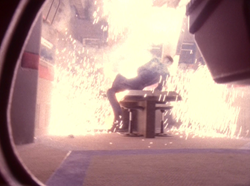 While these shortcuts remained undetected for most of the construction period, the cost cutting measures were discovered during a critical incident that led to the death of five personnel. While loading ordinance near the commissioning date of the Saratoga, a structural failure led to the accidental detonation of a Photon Torpedo. This explosion ignited fuel and hazardous cargo that required venting the impacted compartments to space and jettisoning the cargo stores of the spacecraft to contain the fire. An internal investigation deemed the accident preventable had efforts not been taken to sidestep appropriate safety precautions and appropriate materials been utilized. The Yard Superintendent was arrested by Starfleet Security and the Corps of Engineers implemented cleanup procedures to salvage the Saratoga.
While these shortcuts remained undetected for most of the construction period, the cost cutting measures were discovered during a critical incident that led to the death of five personnel. While loading ordinance near the commissioning date of the Saratoga, a structural failure led to the accidental detonation of a Photon Torpedo. This explosion ignited fuel and hazardous cargo that required venting the impacted compartments to space and jettisoning the cargo stores of the spacecraft to contain the fire. An internal investigation deemed the accident preventable had efforts not been taken to sidestep appropriate safety precautions and appropriate materials been utilized. The Yard Superintendent was arrested by Starfleet Security and the Corps of Engineers implemented cleanup procedures to salvage the Saratoga.
While the christening ceremony for the Saratoga was initially envisioned to have the pomp and circumstance of a flagship class, the incidents of the Saratoga's development led Federation Space Systems to scale back their original plans and the vessel would launch with little fanfare on Stardate 66716.3. Benzite Captain Ratith was assigned to command the Saratoga during her first mission of exploration.
Under Captain Ratith
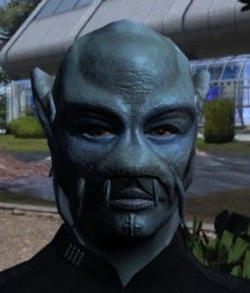 With the fall of the Romulan Star Empire and the power vacuum left from the destruction of this historic power, the United Federation of Planets assigned the Saratoga to the former Romulan Neutral Zone. While the Sagan Class was a multirole explorer designed to push beyond the Federation's frontier, many of the vessel's assignments found it responding to the needs of former Romulan worlds and facing challenges from the diverse array of follow up governments vying for control of the collapsed empire. While the Saratoga was a dedicated peacekeeper, many among its staff were disenfranchised by their lack of exploratory missions and the vessel became a revolving door for personnel during most of its early years. Morale aboard the Saratoga was further eroded when Starfleet Command assigned the ship to escort Federation Merchant Marine freighters to Romulan colonies.
With the fall of the Romulan Star Empire and the power vacuum left from the destruction of this historic power, the United Federation of Planets assigned the Saratoga to the former Romulan Neutral Zone. While the Sagan Class was a multirole explorer designed to push beyond the Federation's frontier, many of the vessel's assignments found it responding to the needs of former Romulan worlds and facing challenges from the diverse array of follow up governments vying for control of the collapsed empire. While the Saratoga was a dedicated peacekeeper, many among its staff were disenfranchised by their lack of exploratory missions and the vessel became a revolving door for personnel during most of its early years. Morale aboard the Saratoga was further eroded when Starfleet Command assigned the ship to escort Federation Merchant Marine freighters to Romulan colonies. In 2392 the Saratoga was selected to transport Federation President Aennik Okeg to the newly established Romulan capital on Rator III. Impressed by his treatment aboard the Saratoga, President Okeg coordinated with Starfleet Command to have the Saratoga reassigned to the Federation Diplomatic Corps to serve as the Presidential Transport. Serving as Starfleet One, the Saratoga saw additional stability and improved morale amongst its crew as it transported the Federation President and his staff throughout the galaxy. The Saratoga took on a ceremonial role in multiple induction ceremonies for new Federation member worlds and was an instrumental component of President Okeg's reelection campaign, serving as his transport while campaigning on multiple Federation worlds.
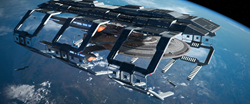 The Saratoga's tenure with the Federation Diplomatic Corps would come to a definitive end in 2400 when President Okeg's term came to a close. While participating in the Inaugural festivities for newly elected President Anton Chekov the Saratoga was significantly damaged during a routine docking assignment at Spacedock. Two crewmembers - Including Captain Ratith - were killed and 47 injured during the accident. Starfleet Command ordered the Saratoga inspected at San Francisco Fleet Yard and an experimental refit implemented to enhance the Saratoga with Borg inspired technologies pioneered aboard the Stargazer.
The Saratoga's tenure with the Federation Diplomatic Corps would come to a definitive end in 2400 when President Okeg's term came to a close. While participating in the Inaugural festivities for newly elected President Anton Chekov the Saratoga was significantly damaged during a routine docking assignment at Spacedock. Two crewmembers - Including Captain Ratith - were killed and 47 injured during the accident. Starfleet Command ordered the Saratoga inspected at San Francisco Fleet Yard and an experimental refit implemented to enhance the Saratoga with Borg inspired technologies pioneered aboard the Stargazer.
Current Assignment
 Refit of the Saratoga was projected to be completed on Stardate 78280.4 (April 13, 2401), leading Starfleet Command to focus efforts on ensuring that the vessel met the deadline to participate in the 250th Frontier Day Anniversary. With the decommissioning of the U.S.S. Enterprise NCC-1701-F and the launch of the U.S.S. Voyager NCC-74656-B scheduled to occur, the Saratoga's relaunch would serve as a third major draw for the event due to the historic nature of the Saratoga's name.
Refit of the Saratoga was projected to be completed on Stardate 78280.4 (April 13, 2401), leading Starfleet Command to focus efforts on ensuring that the vessel met the deadline to participate in the 250th Frontier Day Anniversary. With the decommissioning of the U.S.S. Enterprise NCC-1701-F and the launch of the U.S.S. Voyager NCC-74656-B scheduled to occur, the Saratoga's relaunch would serve as a third major draw for the event due to the historic nature of the Saratoga's name. Moored at San Francisco Yard awaiting authorization to depart, the Saratoga was witness to the USS Enterprise-F departing Sol Station on its final cruise and Admiral Elizabeth Shelby's demonstration of fleet formation mode. While remaining unnetworked, the Saratoga was not initially subject to fleet formation mode and remained active under the power of the Dry dock. Despite this, the crew of Saratoga was partially assimilated by the Borg Collective through the altering of their DNA via the transporter. Every crewmember under the age of 25 succumbed to the Borg virus and began work to eliminate everyone else, starting with the execution of Captain Ospak, the Tiburonian Captain of the Saratoga, while still in his Captain's Chair. Several members of the Bridge crew were able to escape, including First Officer Zseeq.
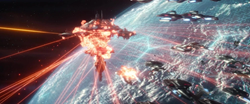 Capturing the Saratoga, the Borg initialized the departure sequence for the vessel and activated the Borg technologies that had been installed during the refit to assist in transmission of the Vox signal to the rest of the fleet. Joining the primary fleet, the Saratoga took position and began firing upon Sol Station while Commander Zseeq and several members of the crew continued efforts to retake the ship from the lower decks. As Sol Station fell, the Saratoga - in historic irony - was tasked with targeting its own namesake community on Earth's surface. As the vessel was preparing to fire, Commander Zseeq and his team were able to cause a momentary loss of primary power. This, coupled with the efforts of the crew of the U.S.S. Enterprise NCC-1701-D, gave the crew the opportunity to retake the Saratoga from the Borg.
Capturing the Saratoga, the Borg initialized the departure sequence for the vessel and activated the Borg technologies that had been installed during the refit to assist in transmission of the Vox signal to the rest of the fleet. Joining the primary fleet, the Saratoga took position and began firing upon Sol Station while Commander Zseeq and several members of the crew continued efforts to retake the ship from the lower decks. As Sol Station fell, the Saratoga - in historic irony - was tasked with targeting its own namesake community on Earth's surface. As the vessel was preparing to fire, Commander Zseeq and his team were able to cause a momentary loss of primary power. This, coupled with the efforts of the crew of the U.S.S. Enterprise NCC-1701-D, gave the crew the opportunity to retake the Saratoga from the Borg.
Due to the relative minor damage experienced by the Saratoga, the ship was quickly repaired and returned to active service. With the loss of many officers in the Borg invasion, Zseeq was promoted to Captain and placed in command of the Starship Saratoga. The Saratoga would be assigned to the Maelstrom soon after and launched on Stardate 78326.9 (April 30, 2401).
Technical Specifications
Physical Arrangement
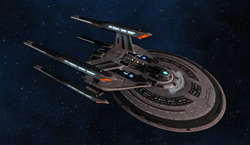 Unlike most contemporary Starfleet vessels, starships of the Sagan Class - like the U.S.S. Saratoga - features a unique physical configuration atypical of most Starfleet ships.
Unlike most contemporary Starfleet vessels, starships of the Sagan Class - like the U.S.S. Saratoga - features a unique physical configuration atypical of most Starfleet ships.Comprising sixteen decks, the primary and secondary hulls of the Saratoga are directly integrated, streamlining the vessel's silhouette by removing the need for a connecting dorsal neck between sections.
Sagan Class vessels have a four Warp Nacelles, enhancing the overall efficiency of the starship's warp field.
Propulsion Systems
Impulse Drive
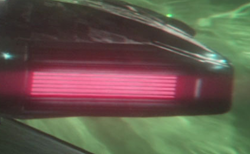 The Impulse Drive is the primary sublight propulsion system used aboard the Saratoga and is used to create impulse power in order to achieve impulse speeds.
The Impulse Drive is the primary sublight propulsion system used aboard the Saratoga and is used to create impulse power in order to achieve impulse speeds. Largely unchanged from the 22nd century to today, the Impulse Drive is essentially an augmented fusion rocket, consisting of multiple fusion reactors, a driver coil assembly, and a vectored thrust nozzle to direct the plasma exhaust. When active, the fusion reaction generates a highly energized plasma that could be employed for propulsion or diverted through the EPS to the power transfer grid, via EPS conduits, so as to supply other systems. When the accelerated plasma was passed through the Driver Coils Assembly, a subspace field that improved the propulsive effect was generated to enhance the vessel's speed.
While Full Impulse is ¼ the speed of light, which is 167,000,000 mph or 74,770 km/s, the Impulse Drive can be used to assist the vessel to penetrate faster than light speeds in an emergency situation, albeit with a lower maximum speed and a higher rate of fuel consumption than the main Warp Drive. This form of travel also increases the likelihood of the Saratoga experiencing relativistic effects, essentially completing an uncontrolled time jump.
Quantum Slipstream Burst Drive
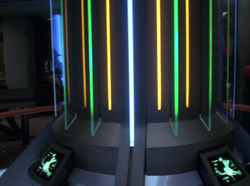 Based upon technology developed by Species 116 in the Delta Quadrant, the Quantum Slipstream Burst Drive is a scaled version of the traditional Quantum Slipstream Drive. The Drive operates by routing energy through the vessel's main deflector, which then focuses a quantum field to allow the vessel to penetrate the quantum barrier and travel through subspace at incredible speeds beyond traditional Warp capability. In order to maintain the Slipstream, the phase variance of the quantum field had to be constantly adjusted, or the slipstream would collapse and violently throw the ship back into normal space, potentially destroying the craft. As an experimental technology, the Drive requires extensive maintenance and is prone to system failure when overused.
Based upon technology developed by Species 116 in the Delta Quadrant, the Quantum Slipstream Burst Drive is a scaled version of the traditional Quantum Slipstream Drive. The Drive operates by routing energy through the vessel's main deflector, which then focuses a quantum field to allow the vessel to penetrate the quantum barrier and travel through subspace at incredible speeds beyond traditional Warp capability. In order to maintain the Slipstream, the phase variance of the quantum field had to be constantly adjusted, or the slipstream would collapse and violently throw the ship back into normal space, potentially destroying the craft. As an experimental technology, the Drive requires extensive maintenance and is prone to system failure when overused. While a traditional Quantum Drive could operate for long periods of time prior to recharge, the Quantum Slipstream Burst Drive was only able to operate for 30 minutes prior to forced shutdown, but the vessel will have traveled 150 light-years in this period. Afterward, the Saratoga's Engineers must reset and recharge the Drive, taking a minimum of 12 hours to successfully complete. The Saratoga can travel at conventional Warp while recharging.
Warp Drive
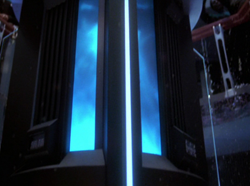 Warp Drive is a propulsion technology that allows the Saratoga and its sister ships to travel at faster-than-light speeds. Warp Drive is considered the linchpin of an interstellar civilization, making trade and exploration across vast interstellar distances viable.
Warp Drive is a propulsion technology that allows the Saratoga and its sister ships to travel at faster-than-light speeds. Warp Drive is considered the linchpin of an interstellar civilization, making trade and exploration across vast interstellar distances viable.Warp Drive works by generating warp fields to form a subspace bubble that envelops the starship, distorting the local spacetime continuum and moving the Saratoga at velocities in excess of the speed of light referred to as Warp Factors. The engines are fueled by the reaction of matter (Deuterium) and antimatter (Antideuterium), mediated through an assembly of Dilithium Crystals, which were nonreactive with antimatter when subjected to high-frequency electromagnetic fields. This reaction produced a highly energetic plasma, called electro-plasma or warp plasma, which was channeled by plasma conduits through the electro-plasma system (EPS); that system also provided the primary energy supply for the ships other electronic systems. For propulsion the electro-plasma was funneled by Plasma Injectors into a series of warp field coils, usually located in remote Warp Nacelles. These coils were composed of Verterium Cortenide and generated the Warp Field.
With its current Warp Drive configuration, Saratoga has a cruising velocity of Warp 7 and a maximum speed of Warp 9.99 that could be sustained for up to twelve hours. Due to its four-nacelle configuration, the Saratoga features two Warp Cores assemblies. Structurally, field stabilizers were placed first in the nacelle design, diminishing the strain on the warp field generator coils located behind. This format allows the Sagan to maintain high speeds for long periods, but at the expense of high-power demands.
Tactical Systems
Multiphasic Shielding
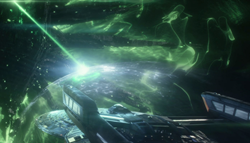 The primary defensive system aboard the Saratoga, shields protect the ship from damage inflicted by enemy forces, hazards, or other phenomenon encountered. Activating automatically when the Saratoga enters Yellow or Red Alert, Shields generate a field of energy around the vessel from the Main Deflector Dish, absorbing damage from the hazard at the expense of shield energy. While Shields will recharge when not in use, with each impact the shield takes damage. As energy drains, power can be rerouted from other shields or systems to reinforce the shield as long as it has not been fully depleted. Once shield energy has been fully lost, the hazard will begin to damage the vessel directly, harming both the ship and its crew.
The primary defensive system aboard the Saratoga, shields protect the ship from damage inflicted by enemy forces, hazards, or other phenomenon encountered. Activating automatically when the Saratoga enters Yellow or Red Alert, Shields generate a field of energy around the vessel from the Main Deflector Dish, absorbing damage from the hazard at the expense of shield energy. While Shields will recharge when not in use, with each impact the shield takes damage. As energy drains, power can be rerouted from other shields or systems to reinforce the shield as long as it has not been fully depleted. Once shield energy has been fully lost, the hazard will begin to damage the vessel directly, harming both the ship and its crew.Saratoga employs Multiphasic Shields, an advanced type of deflector shield technology capable of protecting a vessel from subspace radiation and the dangerous energy emissions generated by stars. Multiphasic Shields can be tuned block transporter signals and prevent the generation of interspatial fissures, helping to better protect the vessel from subspace instability.
Phaser Arrays
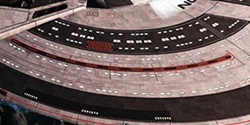 Phaser (short for PHASed Energy Rectification) Arrays are the primary weapon system aboard the Saratoga.
Phaser (short for PHASed Energy Rectification) Arrays are the primary weapon system aboard the Saratoga. Comprised of a linear arrangement of numerous Phaser emitters located in strategic areas of the starship, the Phaser Arrays channel vast energy in a short time frame, with the energy traveling along the emitter strip to find the best position for targeting. Shipboard Phasers are tied directly into the Warp Core, increasing the destructive power of the weapon while having the disadvantage of cutting off most or all phaser power if the Warp Core suffers an antimatter imbalance or if the reactor was damaged. To compensate for this in combat, the Phaser Capacitor - comprising multiple Phaser Power Cells - was developed to store energy for the Phasers during combat; however, these cells are quickly depleted depending upon the nature of combat.
Currently, the Sagan Class Saratoga employs the latest generation Type XV Phaser Arrays, which is a high–quality offensive Phaser capable of inflicting incredible damage on an opponent. Depending on the amount of energy available, Saratoga can fire its Phasers in either a fast or slow rate; however, the faster the rate of fire the lower the destructive potential of the Phaser against an opponent. Further, Phaser energy dissipates over distance, which means that a beam shot from long-range will do less damage than one shot from close range. Saratoga's Phasers could also be used to deliver a traceable payload, meaning that the impact of their weapons fire left residual ionic energy that could be used to track the target.
Torpedo Launchers
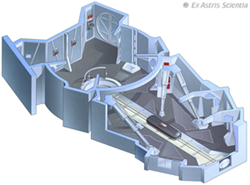 Designed for rapid fire, the Torpedo Launchers aboard the Saratoga can fire multiple projectiles more quickly and accurately that other similarly designed craft. Current projectile options aboard the Saratoga include:
Designed for rapid fire, the Torpedo Launchers aboard the Saratoga can fire multiple projectiles more quickly and accurately that other similarly designed craft. Current projectile options aboard the Saratoga include:
- Photon Torpedo: The Photon Torpedo is the primary heavy weapon aboard the Saratoga. A variant of the Photonic Torpedo developed by the Klingon Empire encountered in the 22nd Century, the Photon Torpedo uses the controlled detonation of matter and antimatter to deliver a devastating energy burst toward a target. Photon Torpedoes can be set with a proximity sensor to detonate prior to impact with a target, lessening the chance of a miss but also decreasing the damage inflicted. Photon Torpedoes can also be overloaded with additional energy to deliver a stronger impact, but this makes the torpedo unstable.
- Probe: While not a traditional weapon, Probes are specialized projectiles that increase the sensor abilities of the Saratoga, providing detailed information about the target or phenomenon encountered. Probes can be transitioned into a makeshift weapon in an emergency but have a poor chance of hitting their target due to the removal of some navigational components.
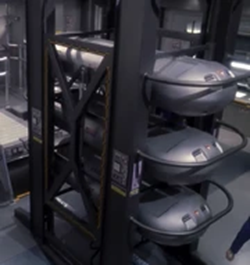
- Quantum Torpedo: Developed as part of the Perimeter Defense Initiative, the Quantum Torpedo was developed by Starfleet to help combat the Borg Collective. Based on the Photon Torpedo, the Quantum Torpedo discharges a higher amount of energy in a projectile of equal dimensions to its predecessor. Utilizing an eleven-dimensional space-time membrane suspended in ultra-clean vacuum within the projectile, the membrane in a Quantum Torpedo is twisted into a string and then isolated from the background vacuum resulting in the creation of a new particle and a tremendous release of energy. Like the Photon, a Quantum can be set to both overload and proximity settings.
Tractor Beam
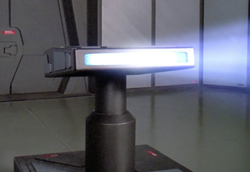 Tractor Beams are attenuated linear graviton beams used by starships, like the Saratoga, to control the movement of external objects. The device operates by placing spatial stresses on the object in specific areas, allowing it to hold the object in a fixed location or alter its position and/or trajectory. Most often used to tow a disabled or vulnerable ship to safety, or sometimes, used by an enemy ship to control the movement of the target vessel, tractor beams could also be set to repel objects.
Tractor Beams are attenuated linear graviton beams used by starships, like the Saratoga, to control the movement of external objects. The device operates by placing spatial stresses on the object in specific areas, allowing it to hold the object in a fixed location or alter its position and/or trajectory. Most often used to tow a disabled or vulnerable ship to safety, or sometimes, used by an enemy ship to control the movement of the target vessel, tractor beams could also be set to repel objects. Featuring multiple external emitters and individual internal units within the Shuttlebays, if a vessel's tractor beam is strong enough its graviton field can reinforce the structural integrity of a target vessel, keeping its hull from succumbing to stresses exhibited by a tractor field. Normally, Tractor Beams were used only at sublight velocities, but it was possible to tow a vessel at warp speed with some risk. The target vessel's engines had to be deactivated to avoid shearing forces against towing vessel and both vessels' speeds needed to be perfectly matched. A tractor beam could also be used to force another vessel out of Warp, but at extreme risk.
Transport Systems
Shuttlebay
 The Shuttlebay is a large facility on the Saratoga where shuttlecraft were launched, received, stored, and maintained. Overlooked by an Observation Deck, ships of the Sagan Class include three rear facing Shuttlebays supported by several hangars. A vehicle replicator, a large-scale replicator able to quickly create any small craft, is available to supplement the Saratoga during long duration missions.
The Shuttlebay is a large facility on the Saratoga where shuttlecraft were launched, received, stored, and maintained. Overlooked by an Observation Deck, ships of the Sagan Class include three rear facing Shuttlebays supported by several hangars. A vehicle replicator, a large-scale replicator able to quickly create any small craft, is available to supplement the Saratoga during long duration missions.In the 23rd Century Shuttlebay operations involved the depressurization of these shipboard facilities, during which time the space doors would open to allow access for spacecraft to the vessel. The implementation of forcefield technology allows the Shuttlebay to remain pressurized when spacedoors were opened. Due to specialized programming, the pressurization forcefields could be traversed by the vehicle while maintaining the pressurization of the Shuttlebay. While the docking procedure is highly automated, Tractor Beam Emitters are fitted to supplement the landing procedure of small craft in an emergency.
Support Craft
Type 14 Shuttlecraft
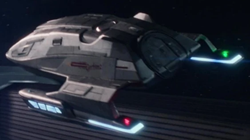 The Type 14 Shuttlecraft serves as a long-range shuttlecraft and is utilized by Starfleet Command in a number of roles throughout Federation territory. Capable of long-distance travel, the Type 14 is often used in a courier role to ferry cargo or personnel from one location to another at high warp velocity. The shuttle is unarmed, but does incorporate defensive shields to protect itself.
The Type 14 Shuttlecraft serves as a long-range shuttlecraft and is utilized by Starfleet Command in a number of roles throughout Federation territory. Capable of long-distance travel, the Type 14 is often used in a courier role to ferry cargo or personnel from one location to another at high warp velocity. The shuttle is unarmed, but does incorporate defensive shields to protect itself.Sixteen meters long, Type 14 shuttles maintain a flight crew of two and can transport as many as six passengers if necessary. A rear hatch, with an integrated docking port, was located along the aft bulkhead of the vessel and gave access to the cockpit. A short-range transporter system is available to personnel for usage should they need to quickly extract themselves from the shuttle.
Assigned Shuttlecraft
All Type 14 Shuttlecraft aboard the U.S.S. Saratoga are named in honor of military personnel who commanded vessels named Saratoga.
- Amelia Hawkins
- Archibald Douglas
- DeWitt Ramsey
- Frank Akers
- Henry M. Mullinnix
- James H. Flatley III
- John Young
- Joseph Stroh
- Lucian A. Moebus
- Matthew Perry
Type 18 Shuttlecraft
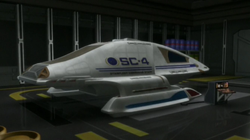 Based upon the Type 9 Shuttlecraft, the Type 18 Shuttlecraft is the most numerous aboard the Sagan Class U.S.S. Saratoga. In its standard configuration, the design can comfortably transport two flight crew and has an enlarged aft section behind the avionics bay to serve as a small cargo compartment. Through its high-performance warp nacelles, the Type 18 can maintain a cruising velocity of Warp 6 for six hours. Type 18 shuttles are lightly armed with Phasers, but can be fitted with a microtorpedo launcher and other defenses depending on mission profile.
Based upon the Type 9 Shuttlecraft, the Type 18 Shuttlecraft is the most numerous aboard the Sagan Class U.S.S. Saratoga. In its standard configuration, the design can comfortably transport two flight crew and has an enlarged aft section behind the avionics bay to serve as a small cargo compartment. Through its high-performance warp nacelles, the Type 18 can maintain a cruising velocity of Warp 6 for six hours. Type 18 shuttles are lightly armed with Phasers, but can be fitted with a microtorpedo launcher and other defenses depending on mission profile.The Type 18 incorporates advanced command and control features that have recently been cleared for Starfleet usage. By default a pilot can control the shuttle through tactile control consoles outfitted with LCARS touch interface, but the advanced artificial intelligence is also capable of utilizing voice commands to operate shipboard systems. Officers with an implanted synaptic transceiver in their brain can also control the Type 18 through thought alone via the sophisticated neural interface built into the craft.
Assigned Shuttlecraft
All Type 18 Shuttlecraft aboard the U.S.S. Saratoga are named in honor of Starfleet Officers who commanded Federation starships named Saratoga.
- Kyle Brody
- Margaret Sinclair-Alexander
- Maurice Vincenzo
- Ospak
- Ratith
- Storil
- Sutik
Type 20 Shuttlepods
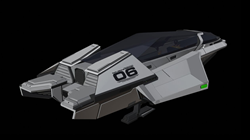 The Starfleet Type 20 Shuttlepod is as a short-range vehicle designed to transport a total of four passengers, often on interplanetary missions. Powered by Impulse Engines, the vehicle could travel short distances at warp when released from the Saratoga while the vessel was at warp velocities. Despite not incorporating a Warp Propulsion System, Type 20 Shuttlepods were defended by deflector shields and could be fitted with Phaser emitters should the vehicle need to defend itself.
The Starfleet Type 20 Shuttlepod is as a short-range vehicle designed to transport a total of four passengers, often on interplanetary missions. Powered by Impulse Engines, the vehicle could travel short distances at warp when released from the Saratoga while the vessel was at warp velocities. Despite not incorporating a Warp Propulsion System, Type 20 Shuttlepods were defended by deflector shields and could be fitted with Phaser emitters should the vehicle need to defend itself.
Assigned Shuttlecraft
All Type 20 Shuttlepods aboard the U.S.S. Saratoga are named in honor of military personnel who served during the Battles of Saratoga.
- Benjamin Lincoln
- Daniel Morgan
- Ebenezer Learned
- Enoch Poor
- Horatio Gates
- James Livingston
- William Whipple
Yellowstone Class Runabout
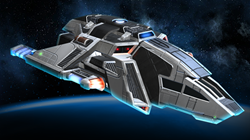 Launched in 2398, the Yellowstone Class Runabout is a specialized support craft that has greater capabilities over a standard shuttlecraft. The evolution of the Danube Class, the Yellowstone Class offers additional living space and the ability to be configured to mission-specific cargo capacities with a maximum payload of 8.9 metric tons. A standard crew complement includes two flight crew and one cargo specialist, but can be changed depending on mission priorities.
Launched in 2398, the Yellowstone Class Runabout is a specialized support craft that has greater capabilities over a standard shuttlecraft. The evolution of the Danube Class, the Yellowstone Class offers additional living space and the ability to be configured to mission-specific cargo capacities with a maximum payload of 8.9 metric tons. A standard crew complement includes two flight crew and one cargo specialist, but can be changed depending on mission priorities.Equal in agility to its Danube Class predecessor, the Yellowstone Class is powered by a tetryon plasma-based propulsion system. Standard performance of the Yellowstone would be Warp 4 for 38 hours and a maximum of Warp 6.2 for 32 hours due to this enhanced propulsion system. One key design flaw in the new system involved a dilithium fracture problem in which the crystals would destabilize over time; however, this was resolved with new plasma flow equations that reduced damage to the crystal. This gave a tactical advantage to the Yellowstone in that the pilot could vent this plasma behind the ship to potentially disrupt the power systems of other starships.
Assigned Shuttlecraft
All Yellowstone Class Runabouts are named in honor of mountains and mountain ranges. The Yellowstone Class Runabout aboard the U.S.S. Saratoga is named the the U.S.S. Tennet Mountain after the highest elevation in Saratoga County, New York on Earth.
Transporters
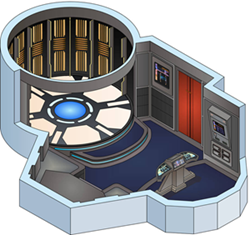 The Transporter is a subspace device capable of almost instantaneously transporting an object from one location to another. Vessels of the Sagan Class have four Personnel Transporter Rooms, which are overseen by a Transporter Chief responsible for the operational readiness, maintenance, and repair of the unit. Standard Transporters have a range of forty thousand kilometers.
The Transporter is a subspace device capable of almost instantaneously transporting an object from one location to another. Vessels of the Sagan Class have four Personnel Transporter Rooms, which are overseen by a Transporter Chief responsible for the operational readiness, maintenance, and repair of the unit. Standard Transporters have a range of forty thousand kilometers.A typical transport sequence, generally initiated by the request of the transportee to "energize", began with transporter pre-sequencing that led to transporter coordinates being established on the object or destination by the targeting scanners to establish a transporter lock. Simultaneously, the object was broken down into a stream of subatomic particles, called the matter stream, before being transferred to the pattern buffer, then again transferring to the emitter array. The matter stream was then transmitted to its destination across a subspace domain, leaving residual ionization in the air. As with other Starfleet technology, the transporter had its own set of safety features, protocols, and procedures. In an emergency, many of these safety systems could be modified or circumvented.
The Transporter saves the biological data of the individuals transported, often comparing the information obtained to an extensive preloaded pattern of common biology of all encountered species in the galaxy. Biofilters were used to decontaminate transported objects and prevent harmful substances, pathogens, and even certain forms of radiation, from contaminating the ship. Previously unknown infections or viruses occasionally failed to register with the biofilters, potentially allowing the threat to get through until the filters were recalibrated to recognize the new threat. Certain weapons could also be deactivated during the transport process.
Awards and Commendations
Categories: No categories found